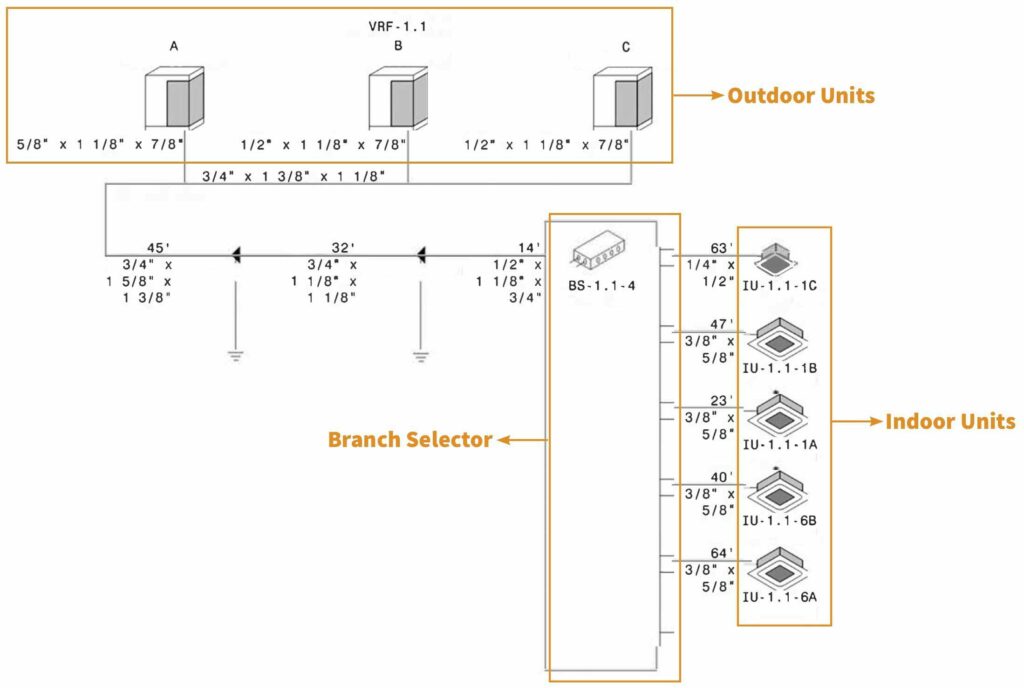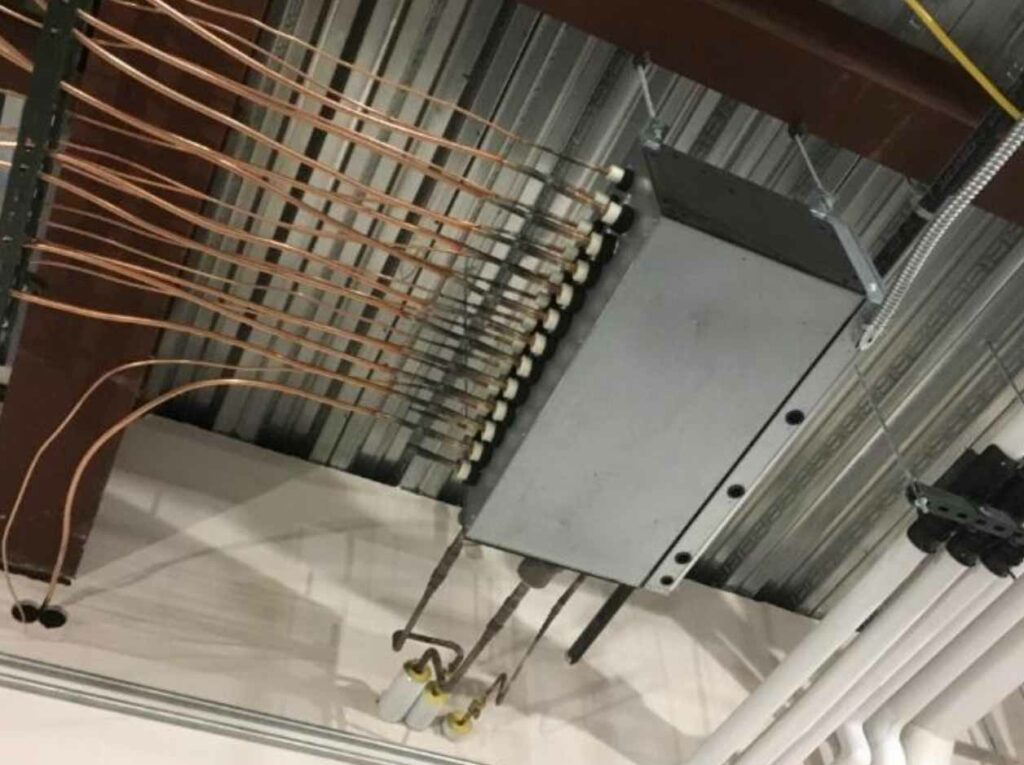Variable refrigerant flow (VRF) systems are well-known for their energy efficiency and versatility. However, VRF System installation presents unique commissioning challenges due to their specific installation needs and the significant impact of proper setup on system performance. As with all commissioning projects, early identification of potential issues ensures systems are operational and meet the owner’s intent.
Commercial VRF systems comprise air or water source condensing units, branch controllers or selectors, and indoor fan coil units or cassettes. These parts are interconnected by two or three refrigerant pipes. Branch selectors direct vaporized or liquid refrigerant to multiple indoor units, depending on heating or cooling requirements, respectively. The number of refrigerant pipes varies by manufacturer and whether the system is designed to support simultaneous heating and cooling.
Ensuring Proper VRF System Installation
Poor VRF System installation can lead to underperformance, which, in the context of VRF systems, is less likely to be easily masked by oversized equipment. Issues are often felt directly by occupants during extreme weather conditions, such as heatwaves and cold snaps. Additionally, poor installation can lead to component failures, such as compressor malfunctions. To guarantee successful installation and operation of VRFs, we recommend consumers to follow the following steps.
Documentation Preparation
Before visiting the site for the first time for installation observation, verify with contractors that you have the latest design drawings, shop drawings and manufacturer’s installation instructions for each system component. Manufacturers may provide detailed requirements such as maximum pipe lengths, recommended piping accessories, and installation guidelines, including lists of do’s and don’ts to help guide installers to a successful installation.
Attending the manufacturer’s pre-installation meeting, if available, can ensure all critical aspects of installation are understood.
Vigilance During VRF System Installation
Referring to the provided documents is a useful approach to compare the installation with the submittal and manufacturer’s instructions.

Spot check branch selectors and indoor units to confirm they are the correct make and model. Projects may incorporate models at multiple capacities, and it is important to ensure each zone has the appropriate unit to meet its capacity requirements.
Additionally, you should inspect piping and control wiring between branch selectors and indoor units, particularly in congested areas, to verify correct termination of the installation that matches the shop drawing. If control wiring is daisy-chained, you should check that each indoor unit matches its assigned address and is correctly terminated at the branch selector.
You should also spot-check piping diameters against the approved shop drawings and ensure the installer records all pipe lengths. Accurate pipe length measurements are crucial for startup technicians to calculate the correct refrigerant amount. Any discrepancies in pipe diameter or length can affect performance and reliability because they will impact the velocity of refrigerant, which is one of the most critical parameters for system functionality.
Confirming that the installer is maintaining accurate red-line documentation to track refrigerant piping is also crucial, especially through inaccessible areas.

Review piping accessories noted on the design documents, if applicable. Designers may or may not require field-installed isolation valves at indoor units. For example, the inclusion of isolation valves at indoor units can vary based on the manufacturer’s feedback. The image above shows a mid-construction photo of a branch selector installed without isolation valves to each indoor unit.
Pete Salmon, PE, CxA, BCxP, LEED AP, Director of Commissioning for the Iconergy team, shares:
On a pair of recent, simultaneous projects with the same designer, same owner, same VRF manufacturer and different mechanical contractors, one contractor installed isolation valves between the branch selector and indoor units and the other did not, at the manufacturer’s request. This led to meetings with all parties to determine a course of action, which in the end was to leave the systems as is, one with valves and one without.
Valves can help with isolating system components when identifying leaks or simplify work on one unit without evacuating refrigerant for the entire system, but they also add a small amount of risk that they are accidentally left closed during pressure testing and they themselves are a source for leaks.
Let Us Help You
The commissioning agent should work closely with the manufacturer’s startup technician, who is invaluable in testing and troubleshooting VRF systems. Participating in the startup process allows the agent to learn the best testing methods and helps identify and resolve issues early, prior to the owner receiving complaints from occupants.
Projects with central control interfaces may have the ability to test many indoor units at the same time, but this is not always a good choice. Overriding all indoor units to cooling is a good test of cooling capacity, but it may not uncover all system deficiencies such as cross-piped or cross-wired units in cases where all indoor units are wired to the branch selector.
— Alex Tangsrud, Commissioning Technician
Cross-piping happens when branch selector ports are incorrectly connected to indoor units or the liquid and vapor lines are swapped at the ports. Similarly, cross-wiring occurs when control wiring from the branch selector is misconnected to different units. Testing each unit individually ensures it responds correctly to heating and cooling requests.
To verify correct unit operation, one recommended method is to force all indoor units connected to a branch selector into cooling mode, and then switch each unit to heating mode one at a time. Use the refrigerant temperatures as feedback to ensure the correct unit receives the appropriate refrigerant. This method, although time-consuming, is recommended to ensure complete system functionality. We recommend either the installing contractor, startup technician, or commissioning agent completes on 100% of units to confirm a 100% complete system.
The Future of VRF Systems
VRF systems are becoming increasingly popular due to their efficiency and potential for immediate and long-term cost savings. As policies shift towards all-electric systems, VRF systems will likely become more prevalent. As you prepare for VRF commissioning projects, take into account what discrepancies between design and VRF System installation may require, what documentation and site observations should focus on, and how you will ensure system functionality for a satisfied client. Proactive and meticulous review is essential to ensure that design intent translates into real-world performance, providing comfort, and cost-effectiveness.